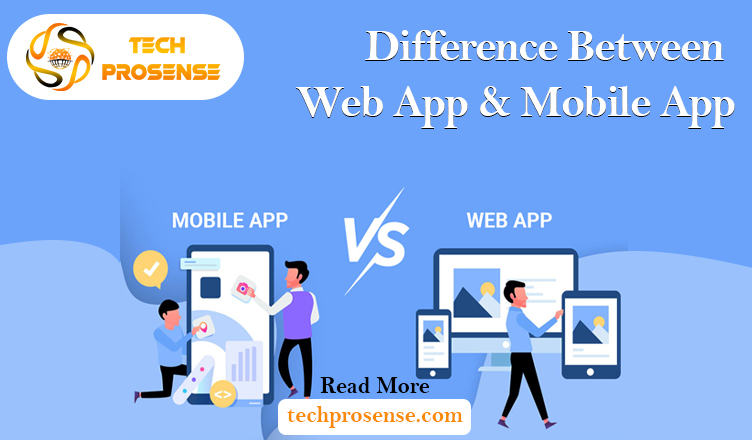-
Call for Anything
+91 9891-888884
-
You may send an email
info@techprosense.com
-
Support Available
24X7


Introduction
With the widespread use of smartphones and internet access in the modern digital age, the need for applications has increased dramatically. Apps are becoming a necessary component of our everyday life, whether they are used for work, play, or productivity, resulting in the creation of many mobile app development firm. However many people and companies frequently find themselves torn between web apps and mobile apps when it comes to selecting the best platform for development. We will examine the differences between web applications and mobile apps in this extensive tutorial, including information on their features, development methods, and applicability for different scenarios.
The primary difference between web app and mobile app is that the former can be accessed through desktop or mobile web browsers, while the latter are installed automatically on tablets or smartphones. A web app doesn't need to be installed in order to use, in contrast to native mobile apps. There are many other significant distinctions and similarities between web apps and mobile apps, all of which will be discussed in this comprehensive tutorial, despite the fact that this is the most evident one.
Though this is a frequent misperception, there is a significant difference between native mobile apps and web apps.It is crucial to distinguish between the two since there are significant differences in both how they are developed and implemented, in addition to how they differ for the user. Overall, a mobile app and a web app differ from one another quite a little.
Web app vs mobile app
Native mobile apps are designed for a particular platform, such Android for Samsung devices or iOS for the Apple iPhone.
They can be downloaded and installed through the app store, and they can use the camera and GPS functions on the system. Mobile apps operate and live on the actual device. Among the most widely used mobile apps are Snapchat, Instagram, and Google Maps.
Conversely, web apps can be accessed using an internet browser and adjust to fit the screen size of the device you're using to see them. That is a basic difference between an app and a website.
They don't require downloading or installation because they aren't built into any specific system. They actually look and work a lot like mobile apps because they are responsive, which is where the confusion lies.
A Web Application: What Is It?
A web application is a programme that is accessed by a user through a browser and is kept on a distant server. Not quite like a website, but close enough.
A website is only a place where users can view content; it is not designed to be interactive. Websites serve the function of displaying static content to users, such as portfolios and official brand websites.
On the other hand, a web application is meant to facilitate communication between the user and the programme. Let's use an example from the world of social media, like Instagram, to help clarify. How do you typically use Instagram? You share your day, send notes to pals, and browse through other posts and reels. These are the ways that you are interacting with the web application. On websites, this is typically not possible. The difference results from this.
How Are Web Applications Operated?
Web and mobile applications are quite different. One of the distinctive features that sets web applications apart from mobile applications is that they can be accessed through a browser and do not require installation as a stand-alone programme on the desktop.
Using a web browser and the internet, the user queries the web server. The server gets ready to deliver the desired request after receiving it. Results are subsequently sent from the web application server to the server by the requested information. The user is subsequently presented with the requested data by the web server.
Web Application Examples
We use a variety of web applications on a daily basis even though we are unaware of them. Among them are carts for online shopping, word processors for emails, altering of images and videos, and scanning of files.
Programming Languages for Developing Web Applications
The web application is developed using particular programming languages to ensure a seamless and error-free surfing experience. Among them are Python, JavaScript, Java, PHP, Quick, Kotlin.
The benefits and drawbacks of web apps
The advantages and disadvantages of web apps are as follows.
They are as follows:
Advantages:
Web apps are adaptable. On desktop and mobile devices, they are accessible through any browser.
Because they update automatically, web applications don't require manual updates.
Since they don't need to be loaded on mobile devices, data and memory are also preserved.
Any OS can be used to execute the cross-platform applications.
Cons:
1- Since web apps are accessed through browsers, they are dependent on the internet and cannot be used offline.
2- Performance slowdown is likely to affect the entire application if there is even a small issue on any of the web application's websites.
3- Web apps operate more slowly than other programmes.
4- Security lapses in web applications are very likely to occur.
What Is a Mobile Application?
A mobile application is, in theory, a software programme created to provide services that are operated on mobile devices. In terms of function, mobile applications and web applications are similar in that they both present content to users, reply to their requests in an optimised manner, and offer a smooth browsing experience.
But there is one distinction. a significant one. Applications for mobile devices are made especially for usage on mobile devices. Mobile applications can only be loaded on mobile devices and can only be seen through them, in contrast to web applications, which can be viewed through any browser on desktop or mobile.
Let's use the well-known mobile app Instagram to better illustrate mobile applications. With more than a billion users, the well-known social media network is well-known for providing high-quality services. Nevertheless, the mobile application is not available for download on a PC; a different version of the programme that is meant to run on a PC is offered instead of the actual mobile application.
How Are Mobile Applications Operated?
Users of mobile applications typically have faster navigation and a more sophisticated browsing experience. They operate in the following ways and consume less internet:
If the user has an Android phone, they download the application from Google Play Store; if they have an iPhone, they get it from the App Store.
The application needs a specific quantity of data and storage space in order to download.
The process of downloading the application begins once it has been confirmed that there is sufficient space on the mobile device.
Before using the applications, the user must either sign up or provide their login information after downloading.
At last, the application is prepared to present its information and offer its services, all while offering a better user experience.
Mobile Application Types
iOS and Android are the two sorts of mobile operating systems, as you may already be aware. The environments, features, and services offered by the two operating systems are very different.
Initially, programmers had to create two distinct versions of the same application, each of which had to be released on the proper operating system. But the procedure has been modified. Now that hybrid apps are being created by developers, the laborious process has altered.
Three categories of mobile applications exist. They are as follows:
Native: An application that is designed to run exclusively on one operating system is referred to be native. Android or iOS is the case. The native APIs of the platform are used in the development of the native applications. You cannot use the same code on different platforms.
Hybrid: Applications that run on both iOS and Android are referred to as hybrid apps. Additionally, the code is platform-neutral and the programme has access to native APIs.
Mobile Web: Web applications seen through a mobile device's browser are referred to as mobile web applications. Mobile web applications seem like mobile applications since most web applications are designed with responsive design. Typically, mobile web applications don't have a distinct mobile application. Users who prefer not to install a certain mobile application also utilise it.
Benefits and Drawbacks of Mobile Apps
The advantages and disadvantages of mobile applications are as follows. They are as follows:
Pros:
1- Unlike web applications, which need laboriously searching and browsing using a browser, mobile applications are simple to access with a single click.
2- The mobile application allows users to save and retrieve data, such as favorites and display preferences, at any time.
3- Companies seeking to enhance their brand recognition might provide a customized experience for their clientele.
Cons:
1- Creating a mobile application is a difficult task.
2- Updates for mobile applications must be made often.
3- Certain mobile apps don't work across platforms.
Differences Between Web and Mobile Applications:
They are both efficient in their own right and offer a sophisticated user experience. Which one should you use is up to you, but in any case, here are some highlights of the differences between a web application and a mobile application so you can see them in more detail:
Applications for mobile devices are made expressly to be used on mobile devices. On the other hand, web applications are designed so that users can explore the content and services using browsers on any device. Web applications may be simply viewed from any browser and do not require installation, however mobile applications must be installed from the app store. Web applications require an active internet connection to function, however, mobile applications can be viewed even when offline. Web applications can take some time to load, while mobile applications load more quickly. The app store must approve mobile applications. Web applications don't need the app store's approval because they may be viewed through browsers. Web applications might not have as high of a level of security as mobile applications, but mobile applications have more advanced security. Updates for mobile apps must be made often. Updates for web apps will be handled by them.
Conclusion
When it comes to service delivery, both web and mobile applications give the user a better experience. We hope you now know how online and mobile applications differ from one another.
Get In Touch
+91 9891-888884
Quick Email us









